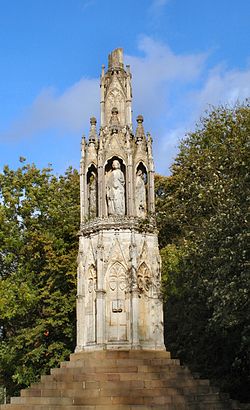Hardingstone
| Hardingstone | |
| Northamptonshire | |
|---|---|
 Queen Eleanor's Cross, London Road, Hardingstone | |
| Location | |
| Grid reference: | SP765575 |
| Location: | 52°12’37"N, -0°52’46"W |
| Data | |
| Population: | 2,014 (2011) |
| Post town: | Northampton |
| Postcode: | NN4 |
| Dialling code: | 01604 |
| Local Government | |
| Council: | West Northamptonshire |
| Parliamentary constituency: |
South Northamptonshire |
Hardingstone is a village and parish in Northamptonshire that forms a suburb on the southern edge of Northampton. It lies about three miles from the town centre. The Newport Pagnell road (the B526, formerly part of the A50) separates the village from the nearby village of Wootton, which has also been absorbed into the urban area.
Facilities
The original village school was built around 1860-70 by General Bouverie; this building remained open until the 1960s or 70s when the primary school was transferred to a more modern building in Martin's Lane, and the old school was transferred to Northampton County Council (Social Services) who now let it to the Hardingstone Village Hall Association.
The village has two pubs - "The Crown" and "The Sun" along with a post office, supermarket and several hairdressers.
Queen Eleanor's Cross
On the edge of the village, on the road going into Northampton, can be found one of only three remaining Eleanor crosses. The cross commemorates the resting at nearby Delapré Abbey of the body of Queen Eleanor of Castile; King Edward I stayed at nearby Northampton Castle. The cross was begun in 1291 by John of Battle; he worked with William of Ireland to carve the statues; William was paid five marks (£3 6s. 8d. or £3.33) per figure.

The cross is octagonal and set on some steps, the present ones being replacements. The cross is built in three tiers and originally had a crowning terminal - possibly a cross. It is not known when this was lost, but it had been lost by the time of the second Battle of Northampton in 1460.
The cross is referred to in Daniel Defoe's Tour through the whole island of Great Britain, where he reports on the Great Fire of Northampton in 1675:
... a townsman being at Queen's Cross upon a hill on the south side of the town, about two miles off, saw the fire at one end of the town then newly begun, and that before he could get to the town it was burning at the remotest end, opposite where he first saw it.
Its bottom tier features open books. These probably included painted inscriptions of Eleanor's biography and of prayers for her soul to be said by viewers, which are now lost.
Church

The parish church of St Edmund dates back to the 12th century and is mentioned in documents from 1107. Pevsner considered that the body of the church had been over-restored.
Many members of the Bouverie family (owners of nearby Delapré Abbey) are buried in the vault - the family used this as their family church because the Abbey, after the dissolution of the monasteries, lacked its own church.
During the war the stained glass windows were removed for safety but afterwards could not be found; some people believe that they might be in the Bouverie family vault - unfortunately this is bricked up and so no-one has tested the theory.
Notable residents
- Robert Adams (sculptor and designer)
- Thomas Croxen Arche] (1817-1885), botanist, and first Director of the National Museum of Scotland
Outside links
| ("Wikimedia Commons" has material about Hardingstone) |
- Pevsner - The Buildings of England - Northamptonshire. ISBN 0-300-09632-1
- Northamptonshire County Council
- Hardingstone Parish Council
- Hardingstone Village Hall